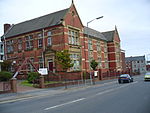Majestic Hotel, Barrow-in-Furness
Buildings and structures in Barrow-in-FurnessGrade II listed buildings in CumbriaGrade II listed hotelsHotel buildings completed in 1904Hotels established in 1904 ... and 1 more
Hotels in Cumbria
The Majestic Hotel (formerly Hotel Majestic) located at Schneider Square in Barrow-in-Furness, Cumbria, England is a 3-star Grade II listed hotel constructed in 1904. The building was designed by JY McIntosh and contains elements of Edwardian and Jacobean architecture. It is also noted for its striking rounded Flemish gables. £1.7 million was spent on refurbishing the hotel in 2008 by developers One Leisure, although ownership of the Majestic, and its nearby sister hotel the Imperial, have since been transferred. The majority of the building's ground floor level is occupied by an Italian restaurant named Francesca's.
Excerpt from the Wikipedia article Majestic Hotel, Barrow-in-Furness (License: CC BY-SA 3.0, Authors).Majestic Hotel, Barrow-in-Furness
Michaelson Road,
Geographical coordinates (GPS) Address Nearby Places Show on map
Geographical coordinates (GPS)
| Latitude | Longitude |
|---|---|
| N 54.1108 ° | E -3.227 ° |
Address
Michaelson Road
LA14 1HP , Hindpool
England, United Kingdom
Open on Google Maps






